This post is a first version of my thoughts about how to satisfy a need I have when discussing with certain type of clients (my user). Here you can see where this come from.
This post contains more questions than answers. Challenge the concepts exposed here, all constructive feedback is welcome.
Where I started to think about this
I review from time to time this Wardley map done by Simon:

And I focused on the Purpose: Explain topographical intelligence to the world of business.
I start from the point that Wardley Mapping is an emergent practice and I was asking myself:
1.- What are the reasons that Wardley Mapping does not become a good practice?
This is the first question I still has not a good answer.
Coming back to my user (a senior person working in a large company), I was thinking about the problem of scaling the use of Wardley Mapping in that type of environment. These type of people have very limited time to invest on this type of coaching/training and cannot go beyond the people they talk directly. There should be other mechanisms that enable this without depending on some few folks.
Time is also a relevant variable, if you are looking at the long term, you can place some seeds and enable them to see which ones are growing up. But this approach takes time, patient and this is not always possible. Planting seeds in a small garden is nice but is much different that planting seeds in an large field where you are expecting that investment to provide some return.
The word that stay in my mind is scale, and from here the second question.
2.- How can Wardley Mapping being used at scale?
To build an ad-hoc solution for my customer is something I can do, that’s not a problem. The problem is that I’m not satisfying his expectations. What are his expectations?
- He is expecting to have a set of training courses for different type of mapper needs (like a menu in a restaurant).
- He is expecting that the waiter explains the content of each food in the menu and think about where to start, what is the main important mean and finish with the dessert. He basically wants to build a training plan that will be part of his adoption plan inside of his organization.
- He is expecting to know what are the more popular meals (the waiter helps on that).
So thinking about these expectations I was looking at Wardley Mapping as model and see what it needs around and what can help people to enjoy it.
I was thinking about riding, Wardley Maps is like riding a bicycle, you get a lot of fun, you are quick in the city as can scape of traffic jam, you can park almost anywhere and use it again. But it has a difficult part: you have to learn to ride. This puts me into the “training wheels”.
My friend Dani told me about not using training wheels for my son, “they are useless, he will learn quickly if you help him to use without training wheels”. He was right, I was supporting him and thanks to my good shape my back was not bad at all (I’m 192cms tall and to run behind a 3 years old kid with a bike takes some effort). The point is that not everybody can do what I did because they are not passionate about bikes, they do not have time, they are not in good shape to do it… and this is the reason training wheels exist.
3.- What could be a good bicycle training wheels for Wardley Mapping?
I have no a final answer for it, but I have an idea and some initial feedback. My idea is a framework, the initial feedback I received is: you need a transition program, an adoption plan…
So, Joaquín, can you concrete your idea?
My idea about a Wardley Mapping Framework 0.1
The central idea is around this:
- Enable a path for adoption of Wardley Mapping for those who are looking for a fast adoption of the model/tool.
- The components of the framework are: events, roles, maturity model and processes.
- The components of the framework are like pillars that enable the novel apprentice to orientate itself on the model. They are the bicycle training wheels.
- They are right now in genesis stage.
- Serve as menu or training wheels for the adoption of the Wardley mapping at scale in an large organization.
- The Wardley Mapping model evolves and the framework will need to adapt to the changes happening in the model.
- The framework description should be brief.
- The framework is a guidance that needs to be tailored for each given context.
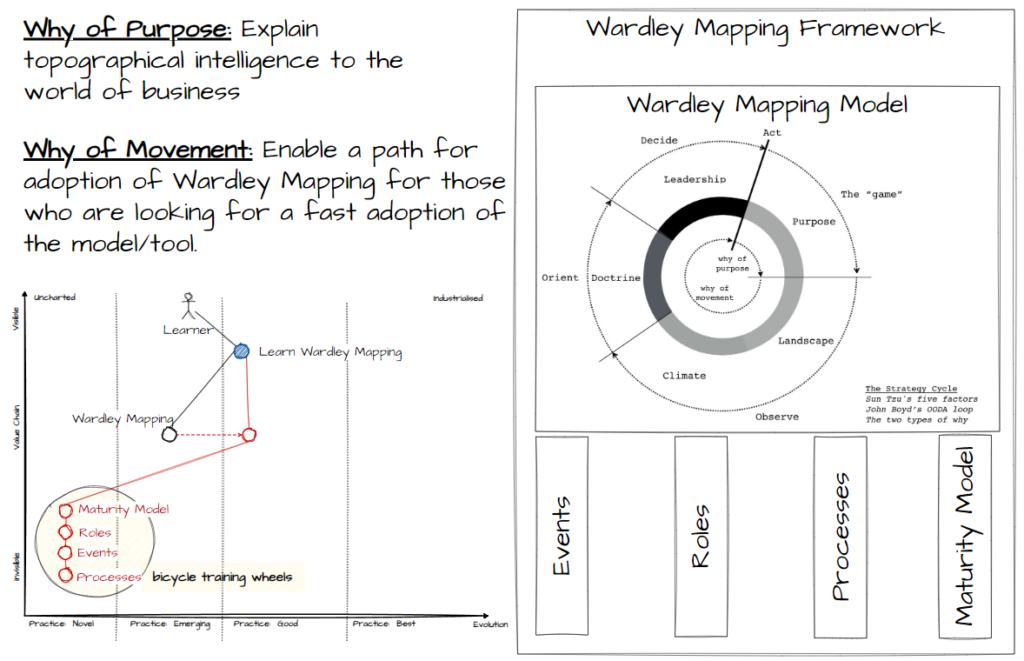
4.- Is there any other pillar that should be taken into consideration?
Scrum and Wardley Mapping
On the diagrams and tables I’m going to add you will see notes around Scrum. There are some reasons about it.
- Scrum and Wardley mapping have some important things in common: OODA loops, feedback as source of information, some of the principles, recognize the need of working autonomous way, the flow, etc.
- They are very well accepted in the software development and product development space, but not outside of it (there are some exceptions). To me the reason is that Scrum covers well the context of SDLC and product development, but not the business context. Here is where Wardley Mapping and its artifacts contribute to the business space: climatic patterns, doctrines, inertia and gameplays.
So, now you will read about my idea on each of these components.
Roles
There are several names to the roles as I do not know what are the more appropriate. Any suggestion?
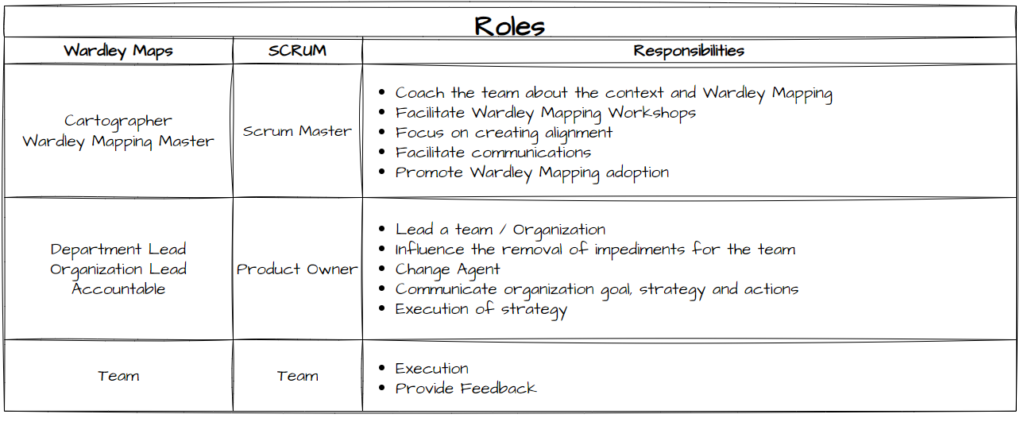
Maturity model
This maturity model to me is like the menu, where the person selects for a large organization a set of training plans for different people. It’s a guidance.
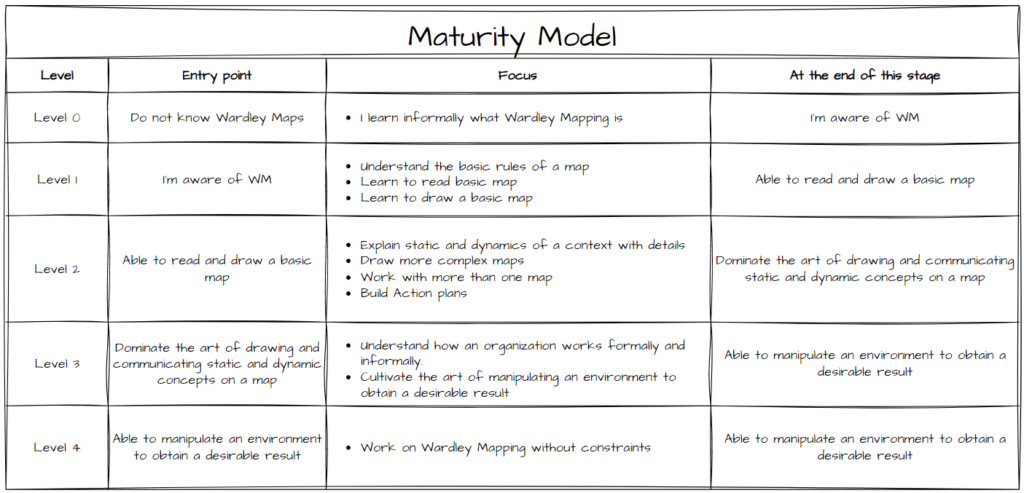
An example:
- I have 150 people where I would like them to have the ability to access to training about how to read & draw a basic map (completely optional for them).
- I have 10 people with team responsibilities that I want them to be training to the level of being able to define where they are and there they are going on using Wardley Mapping.
- I have 5 people leading business units which have to be trained to be able to do what Team Leads do and be able to go beyond in the analysis of their context (outside of the company).
So in total, in terms of training: 150 “level 1”, 10 “level 2”, and 5 “level 3”, then the real adoption of this with business result is a different story that needs to be driven separately.
Using the analogy of the bikes:

Events
I need to define this well, but I hope people familiar with Scrum understand it.

Processes
I have received the following question many times:
4.- What is the purpose of using Wardley Mapping?
My short answer is “communications”, which does not satisfy the inquirer.
My second answer is: I use on my programs, which does not satisfy either.
So, I created this:
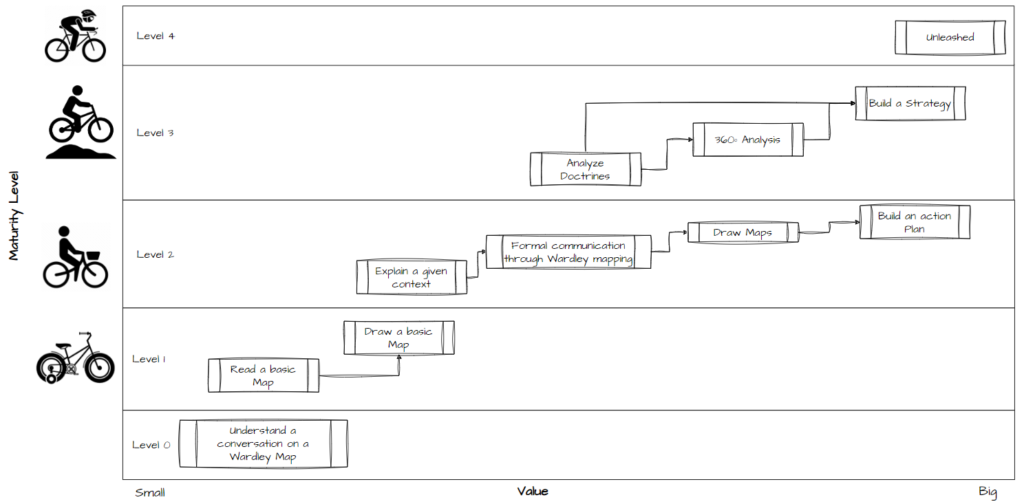
When reading it, think about the conversation with the user defined before.
Before the processes:
- Wardley Mapping is not procedural and precisely industrializing his agility can kill his agility.
- The core of the framework is not the map, neither other artifacts, the core is the conversation and the ability to make decisions. Conversation flow and ability to make better decisions is the key concepts. Both concepts are difficult to measure. The best way to measure: consensus about doctrines adoption.
- These processes require a set of use cases to put in practice. The number of use cases is infinite, but common uses can be used as reference for the learner.
The draft definition of the processes (which serve as guidance):
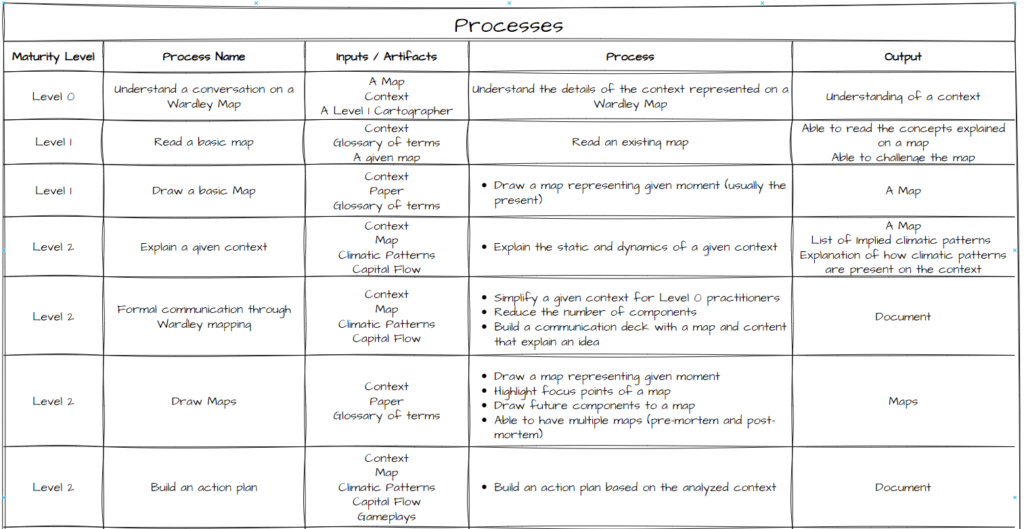
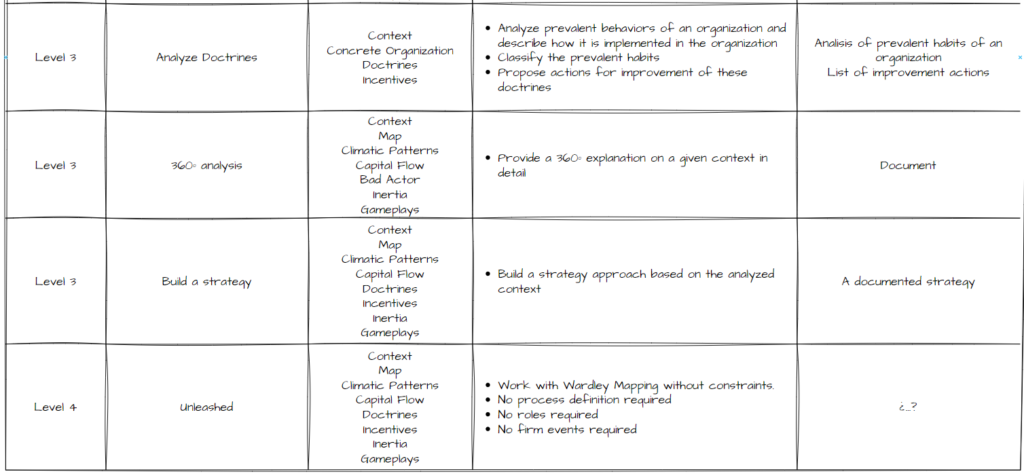
Metrics
In terms of adoption the main target of Wardley Mapping is to be useful. If they are useful, you got it.
This is not enough for you, ok, then let’s go to the doctrines table.
- Do an initial assessment of the prevalent doctrines you have in your organization (easy classification: red, orange, green).
- Define a set of actions to work on to improve these habits,
- Measure it from time to time (organize a review meeting to do it and have consensus about the reality).
- The ideal stage is to have a lot of green spots on the table.
- Major disruption events can turn that some of these patterns to turn red or orange again.
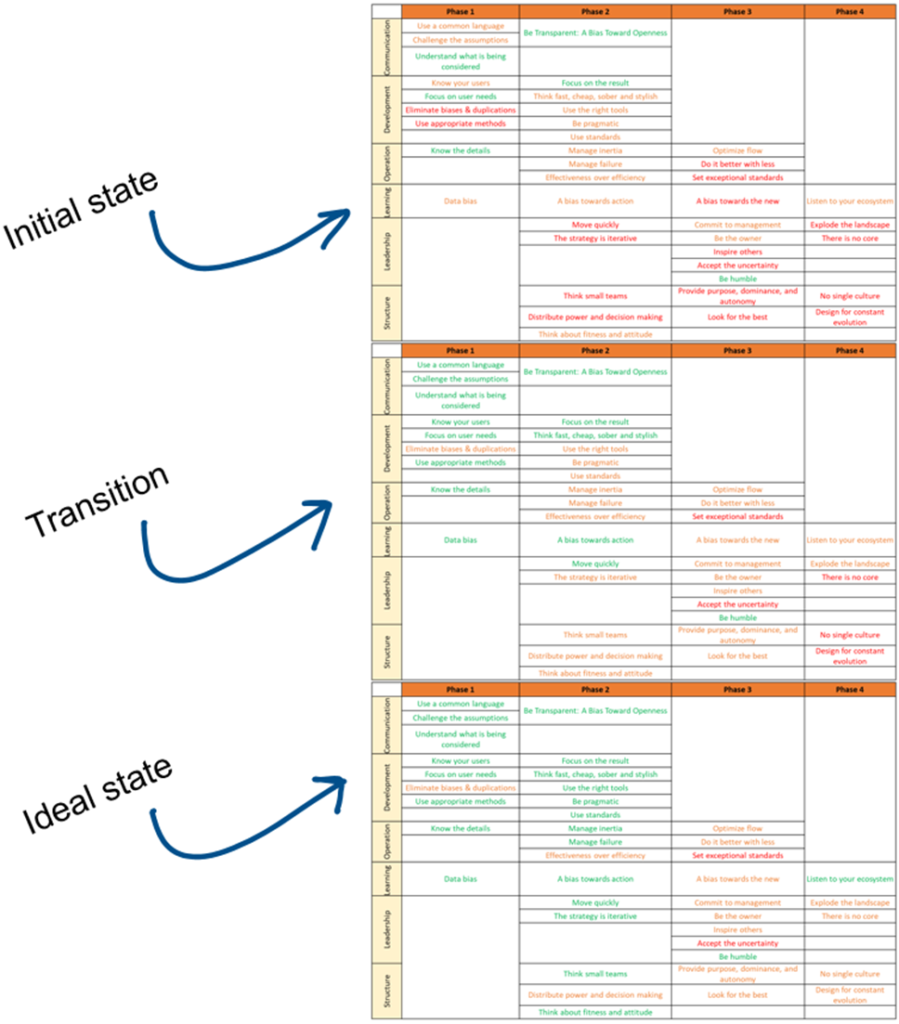
Takeaways
Well, this is a draft and I hope it results interesting to see a different perspective. After writing it some new ideas have come out to my mind, but I will let them here.
As usual, any constructive feedback is welcome.